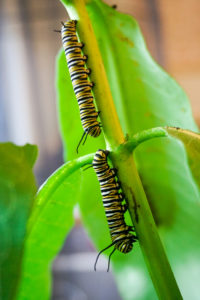
As summer comes to a close, we all begin to see the yellow golden rod and other late summer blooming flowers. However, if you begin to really look more closely you might come across a rare sight – a small patch of milkweed. Milkweed is becoming rare due to excessive roadside cutting. Also the common population of humans sees the plant as a weed and thus pulls it up. This plant is vital to these important members of our ecological “team”, particularly the Monarch butterfly.
Both Teacher Megan (Kindergarten) and I have collected some Monarch caterpillars that are presently residing in our classrooms. It is a great opportunity for our students to witness the process of metamorphosis right before their eyes. The caterpillars are on a milkweed plant under a screened enclosure. After they get to a certain size they will go in a “J” shape and then into a green cocoon called a chrysalis. After about 10 to 12 days the monarch butterfly will emerge with all its glory, pump its new wings, feed on provided goldenrod, and then they are released for their journey towards that small patch of forest in Mexico!
FSMH students and families are free to visit our classrooms or the patch of milkweed by Teacher Nancy’s room to watch this awesome nature spectacle. If you find a patch of milkweed near where you live, check out the underside of the leaves to find and observe these delicate creatures. We love our Monarchs, so please don’t cut down the milkweed!
I look forward to exploring the Friends campus and the neighboring Friends Woodland Preserve to discover nature with our students throughout the school year.
This blog post is by Teacher Peter, our campus naturalist who leads students of all ages on outdoor learning adventures throughout the school year.



Follow and Contact Us